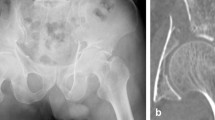Abstract
There are only four reports on unilateral occlusion of the common iliac artery following ipsilateral anterior retroperitoneal approach to the lumbar spine. To the authors' knowledge, there are no previous reports on delayed bilateral iliac artery occlusion following retroperitoneal approach. We report on a rare case of a 37-year-old paraplegic man who sought this department with bilateral iliac artery occlusion and simultaneous unilateral thromboembolism to the left popliteal artery. The problem occurred following retroperitoneal approach for instrumentation of an L2 fracture performed 2 years ago. The left leg was amputated above the knee because of gangrene, while a left-sided abdominal-to-femoral artery bypass was performed to salvage the right leg. Six months later, the right leg was amputated below the knee because the patient was admitted again with gangrene of his right foot. Following that, the loosened anterior hardware was removed via a right retroperitoneal approach. Revision surgery revealed an apposition of the common iliac vessels from the loosened hardware, while the vertebral bodies at the affected area were severely osteoporotic. Spine surgeons should be aware for the appearance of this disastrous complication following anterior retroperitoneal surgery in patients with loss of sensation in the lower extremities who do not present subjective symptoms of ischemia. The presence of hardware loosening and migration, loss of correction and pseudarthrosis are the warning signs for diagnosis of such a complication.
Résumé
On ne retrouve que quatre publications d'occlusion unilatérale de l'artère iliaque primitive après abord rétropéritonéal ipsilatéral du rachis lombaire. A la connaissance des auteurs, il n'existe aucune publication sur une occlusion bilatérale dans un tel abord rétropéritonéal. Nous rapportons le cas d'un homme âgé de 37 ans, paraplégique, qui séjourna dans notre service avec une occlusion bilatérale et une thrombose par embolie de l'artère poplitée gauche à la suite d'un abord rétropéritonéal qui avait été effectué deux ans auparavant pour stabiliser par instrumentation une fracture de L2. Le membre inférieur gauche dut être amputé au dessus du genou en raison d'une gangrène et un by-pass abdomino-fémoral gauche dut être réalisé pour sauver le membre inférieur droit. Six mois plus tard, on dut amputer la jambe droite sous le genou en raison d'une gangrène du pied. Dans les suites, il fut procédé à l'ablation du matériel par un abord rétropéritonéal à droite. Le contrôle chirurgical permit la découverte d'une adhérence entre l'artère iliaque primitive et le matériel d'ostéosynthèse qui avait migré; les corps vertébraux concernés étaient fortement ostéoporotiques. En conclusion, les chirurgiens du rachis doivent être conscients d'une telle complication catastrophique après abord rétropértionéal du rachis lombaire, chez des patients ayant perdu la sensibilité aux membres inférieurs et ne se plaignant pas, de ce fait, de symptomes ischémiques. La présence de matériel d'ostéosynthèse débricolé, ayant migré, la notion d'une perte de correction et d'une pseudarthrose sont les signes d'alarme qui doivent faire évoquer la crainte d'un tel diagnostic.




Similar content being viewed by others
References
Baker JK, Reardon PR, Readon MJ et al (1993) Vascular injury in anterior lumbar surgery. Spine 18:2227–2230
Dearborn TJ, Hu SA, Clifford BT, Bradford SD (1999) Thromboembolic complications after major thoracolumbar spine surgery. Spine 24:1471–1480
Faciszewski T, Winter RB, Lonstein JE, et al (1995) The surgical and medical complications of anterior spinal fusion surgery in the thoracic and lumbar spine in adults : a review of 1.223 procedures. Spine 14:1592–1599
Hackenberg L, Liljenqvist U, Winkelmann W (2001) Occlusion of the left common iliac artery and consecutive thromboembolism of the left popliteal artery following anterior lumbar interbody fusion. J Spinal Disord 14:365–368
Khazim R, Boos N, Webb JK (1998) Progressive thrombotic occlusion of left common iliac artery after anterior retroperitoneal approach to the lumbar spine. Eur Spine J 7:239–241
Marsicano J, Mirovski Y, Remer S, et al (1994) Thrombotic occlusion of the left common iliac artery after an anterior retroperitoneal approach to the lumbar spine. Spine 19:357–359
McDonnel MF, Glassman SD, Dimar RJ, et al (1996) Perioperative complications of anterior procedures on the spine. J Bone Joint Surg [Am] 78:839–847
Raskas DS, Delamarter RB (1997) Occlusion of the left iliac artery after retroperitoneal exposure of the spine. Clin Orthop 338:86–89
Watkins R (1992) Anterior lumbar interbody fusion surgical complications. Clin Orthop 284:47–52
Author information
Authors and Affiliations
Corresponding author
Rights and permissions
About this article
Cite this article
Korovessis, P., Koureas, G. & Zacharatos, S. Bilateral occlusion of common iliac artery following anterior retroperitoneal approach for lumbar fracture instrumentation. Eur J Orthop Surg Traumatol 13, 111–114 (2003). https://doi.org/10.1007/s00590-003-0073-6
Received:
Accepted:
Published:
Issue Date:
DOI: https://doi.org/10.1007/s00590-003-0073-6
Keywords
- Anterior retroperitoneal spine instrumentation
- Iliac artery occlusion
- Vascular complication
- Lumbar vertebra fracture




